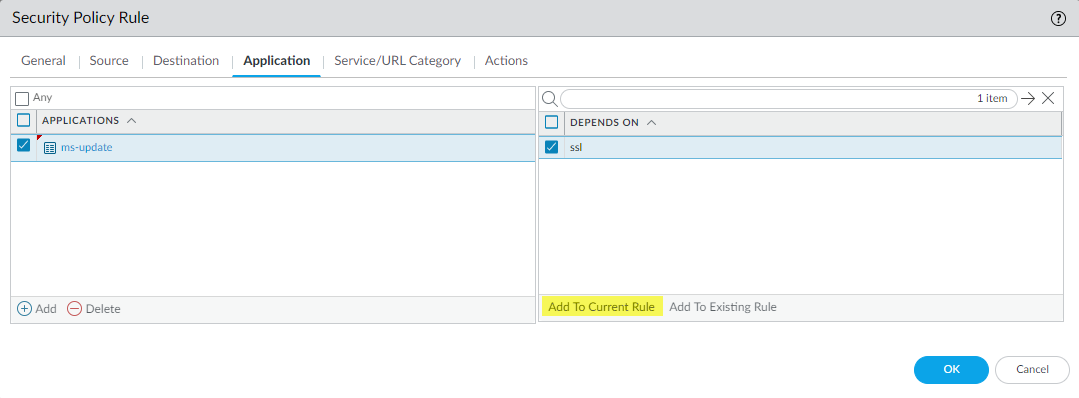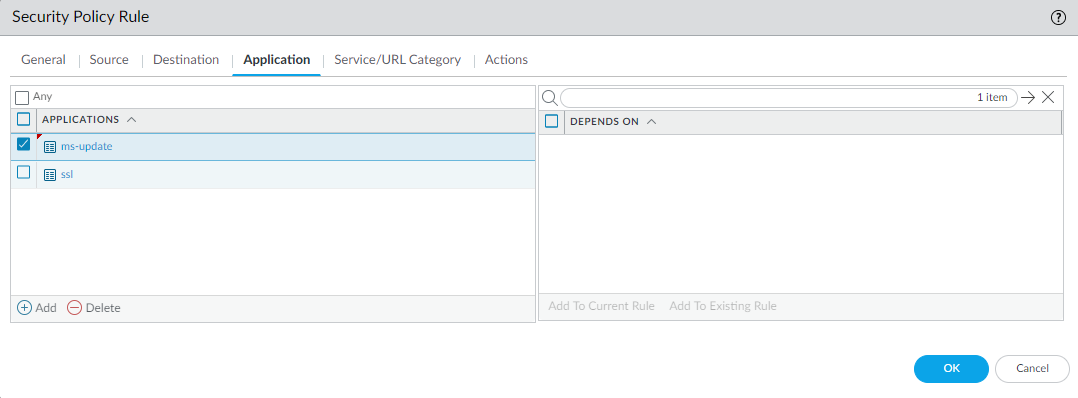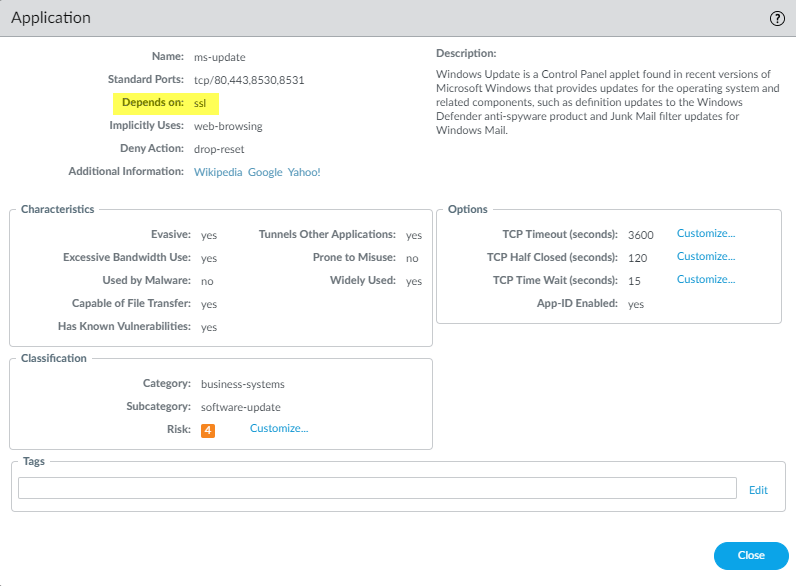Create Data-Center-to-Internet Application Allow Rules
Table of Contents
10.1
Expand all | Collapse all
-
- What Is a Data Center Best Practice Security Policy?
- Why Do I Need a Data Center Best Practice Security Policy?
- Data Center Best Practice Methodology
- How Do I Deploy a Data Center Best Practice Security Policy?
- How to Assess Your Data Center
-
- Create the Data Center Best Practice Antivirus Profile
- Create the Data Center Best Practice Anti-Spyware Profile
- Create the Data Center Best Practice Vulnerability Protection Profile
- Create the Data Center Best Practice File Blocking Profile
- Create the Data Center Best Practice WildFire Analysis Profile
- Use Cortex XDR Agent to Protect Data Center Endpoints
- Create Data Center Traffic Block Rules
- Order the Data Center Security Policy Rulebase
- Maintain the Data Center Best Practice Rulebase
- Use Palo Alto Networks Assessment and Review Tools
Create Data-Center-to-Internet Application Allow Rules
Enable the appropriate data center servers to connect to update servers, certificate
revocation servers, and other necessary servers and prevent connections to illegitimate
servers.
The main use case for data center servers
initiating connections to external servers on the internet is to
update software or to obtain certificate status. The greatest risk
is connecting to the wrong server, especially for Linux updates
because there are many third-party URLs to which you may inadvertently connect.
Ensure that your data center servers receive updates from legitimate
update servers, using only the required applications on their default
ports.
To do this, create strict application allow rules that
limit the external servers to which data center servers connect
and the applications that data center servers use when connecting
to external servers. Tag all sanctioned applications with the
predefined Sanctioned tag. (Panorama and firewalls consider applications
without the Sanctioned tag as unsanctioned applications.) A strict
application allow rule set disrupts potential attacks by:
- Preventing malware that is already on a data center server from connecting to a compromised external server (phoning home) and downloading additional data because the allow rules don’t allow connections to those servers.
- Preventing attackers from using legitimate applications such as FTP, HTTP, or DNS tunneling to exfiltrate data or using legitimate applications such as web-browsing on non-standard ports for command-and-control (C2) operations because the allow rules don’t allow data center servers to communicate with the internet using those applications. An additional way to help prevent exfiltration is to use the File Blocking profile’s Direction control to block outbound update files so you only allow downloading for software update files.
Create
a strict allow rule for each application that requires software
updates from a different set of external servers. In many cases,
App-ID alone isn’t enough to protect data center servers. For example,
for Linux server updates, it’s not enough to limit traffic to an
update application such as yum or apt-get because
that doesn’t prevent connecting to illegitimate servers. The best
practice is to find the URLs that data center servers need to connect
to, create custom URL categories (ObjectsCustom ObjectsURL Category)
that specify the websites to use, and combine them with App-ID in
Security policy rules. The combination of App-ID and custom URL
categories locks down the external servers with which the data center
servers can connect by preventing the use of illegitimate applications
and preventing connections to update servers that aren’t in the custom
URL category. For example, in a Security policy rule that allows
data center servers to connect to CentOS update servers, you could
create a custom URL category called CentOS-Update-Servers and
add the CentOS update sites your servers use to the custom category.
To find out the URLs of legitimate Linux update
servers and other update servers, work with software engineering,
development operations, and other groups that update software to
understand where they go to get updates. You can also log web browsing
sessions, collect the URLs to which developers connect, and then
take the URLs to engineering to filter out the right URLs for the
Security policy.
Don’t use the URL Filtering
Profile (PAN-DB URL Filtering) in Security policy rules for data
center servers that communicate with the internet because you don’t
want to allow all update servers. Restrict communication so that
data center servers only reach out to the particular servers from
which they retrieve updates.
In addition, all allowed
communication should occur on the standard ports for each application.
No applications should run on non-standard ports. As with all data
center traffic, monitor allow rule violations because violations
indicate either that you need to update the security policy to allow
legitimate traffic or that an adversary is in or is attempting to
enter the network.
Order
the Data Center Security Policy Rulebase shows you how to
order these rules with all of the other rules we create for the
other three data center traffic flows and the block rules so that
no rule shadows another rule.
To apply
consistent security policy across multiple data centers, you can reuse templates and template stacks so
that the same policies apply to every data center. The templates
use variables to apply device-specific values such as IP addresses,
FQDNs, etc., while maintaining a global security policy and reducing
the number of templates and template stacks you need to manage.
Each
of the following allow rules:
- Has the best practice Security profile group attached, which consists of the best practice Security profiles. Using a Security profile group enables you to apply all of the best practice profiles to a rule at one time instead of specifying each profile individually. Security profile groups make configuring protection against malware, vulnerabilities, C2 traffic, and known and unknown threats faster and easier.
- Logs traffic (at session end) so that you can track and analyze rule violations and includes log forwarding. Forward logs to log servers and when applicable, forward log emails to appropriate administrators.
- Allow data center
servers to access software update servers.This rule shows how to restrict access to software update servers on the internet so that data center servers communicate only with legitimate, known servers and don’t communication with other external update servers. This example allows engineering data center servers to access CentOS update servers and restricts communication to using only the necessary applications to establish connections to only the right set of update servers.
![]() To create this rule:
To create this rule:- Restrict the source of CentOS update requests to only the data center servers that need to retrieve updates, in this example the Dev-Servers dynamic address group in the Engineering-DC-Infra zone.
- Restrict the application(s) that data center servers can use to communicate with external update servers to only the required application(s), in this example, yum for CentOS updates. Only allow the application(s) to run on the default port to prevent evasive malware from attempting to use non-standard ports.
- Create a custom URL category to define the URLs of the update servers to which the data center servers can connect. In this example, the CentOS-Update-Servers custom URL category defines the update server URLs that the data center servers can reach.
This combination of restrictions also prevents attackers who have already compromised a data center server from reaching other destinations and using other applications to exfiltrate data or download additional malware.Similarly, a rule allowing the same servers to communicate with Microsoft Windows update servers uses the same construction.![]() The source zone and address are the same as in the preceding CentOS update rule. The differences are:
The source zone and address are the same as in the preceding CentOS update rule. The differences are:- The custom URL category (Win-Update-Servers) contains the URL for Windows updates so that contact with other URLs is denied.
- The applications pertain to Microsoft updates. In addition to the ms-update application, Microsoft updates require the ssl application because ms-update depends on SSL. As with the CentOS update rule, only standard ports are valid.Some applications depend on other applications. For a given application, you must allow all dependent applications or the application won’t work. The user interface shows application dependencies when you create a Security policy rule. For example, when you specify the ms-update application in the rule, the interface shows that ms-update depends on also allowing SSL:
![]() Click Add to Current Rule to add the selected application(s) to the rule.
Click Add to Current Rule to add the selected application(s) to the rule.![]() You can also use the Search function (ObjectsApplications) to find application dependencies. For example, to find the dependencies for the ms-update application, search for ms-update, click the ms-update application in the resulting application list, and then check the Depends on: field.
You can also use the Search function (ObjectsApplications) to find application dependencies. For example, to find the dependencies for the ms-update application, search for ms-update, click the ms-update application in the resulting application list, and then check the Depends on: field.![]()
- Allow data center servers to access DNS and NTP update
servers.This rule shows how to restrict access to DNS and NTP update servers on the internet so that data center servers communicate only with legitimate, known servers. This example allows IT data center servers to access DNS and NTP update servers and restricts communication to using only the necessary applications to establish connections to only the right set of update servers.Allow traffic only to sanctioned DNS servers. Use the DNS Security service to prevent connections to malicious DNS servers.
![]() To create this rule:
To create this rule:- Restrict the source of DNS and NTP update requests to only the data center servers that need to retrieve updates, in this example the DNS-NTP-Servers dynamic address group in the Engineering-DC-Infra zone.
- Restrict the applications that data center servers can use to communicate with these external update servers to only the required applications, in this example, dns and ntp. Allow the applications to run only on the default port to prevent evasive malware from attempting to use non-standard ports.
- Create a custom URL category to define the URLs of the update servers to which the data center servers can connect. In this example, the NTP-DNS-Update-Servers custom URL category defines the update server URLs that the data center servers can reach.
- Allow data center servers to access certificate authority
servers to obtain the revocation status of digital certificates
and ensure that they are valid.This rule enables data center servers to connect to an Online Certificate Status Protocol (OCSP) Responder (server) on the internet to check the revocation status of authentication certificates. An OCSP Responder provides the most recent certificate status compared to browser Certificate Revocation List (CRL) updates, which depend on the frequency of CRL browser updates to keep up with certificate revocations, so the CRL is more likely to be out-of-date than an OCSP Responder. When you configure a certificate profile on the firewall, you can set up CRL status verification as a fallback method for OCSP in case the OCSP Responder is unreachable.
![]() To create this rule:
To create this rule:- Restrict the source of certificate revocation check requests to only the data center servers that need to check certificate validation, in this example the IT-Server-Management dynamic address group in the IT-Infrastructure zone.
- Restrict the applications that data center servers can use to communicate with external certificate revocation servers to only the required applications. This example secures the connection between data center servers and OCSP Responders, so the only application to specify is ocsp. Allow the application to run only on the default port to prevent evasive malware from attempting to use non-standard ports.
Verify that only the applications you explicitly allowed
in the security policy rules are running by viewing the predefined
Applications report (MonitorReportsApplication ReportsApplications). If you see unexpected
applications in the report, review the application allow rules and
refine them so that they don’t allow the unexpected applications.







